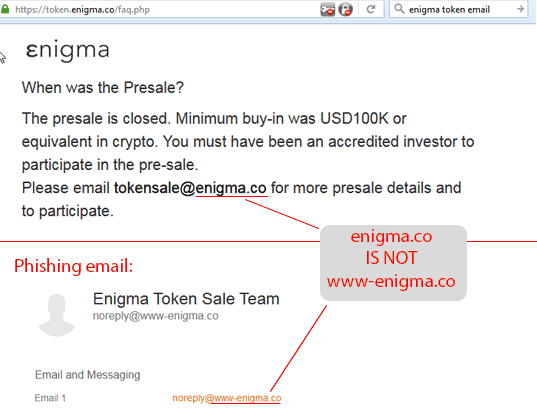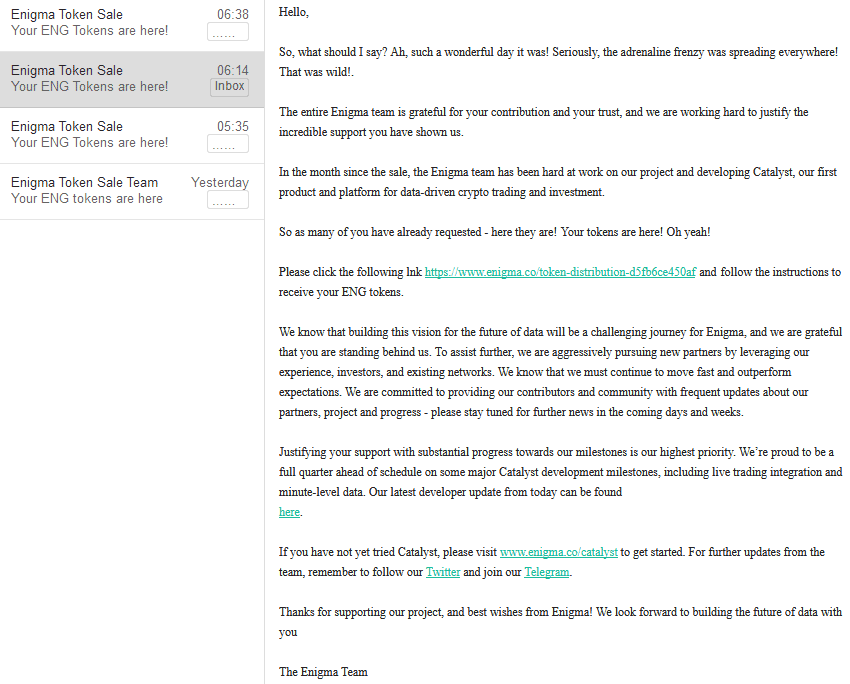GUIDE: How to protect against phishing-mails [CRYPTOCURRENCY - BITCOIN]
GUIDE: How to avoid getting phished via email
Cryptocurrency is gaining more and more popularity, also to non-tech-savvy people.
For scammers, this is a good chance to get some easy money, and I already noticed that there are more and more people complaining about phishing attacks and stolen wallets/coins.
That's why I thought it is needed to write an easy to understand guide about how to prevent getting phished or scammed, based on a real example that just happened today.
- Phishing definition:
The fraudulent practice of sending emails purporting to be from reputable companies in order to induce individuals to reveal personal information, such as passwords and credit card numbers.
...or our cryptocurrency privatekeys.
How to identify phishing-mails:
Today I noticed 4 eMails in my inbox, titled "Enigma Token Sale - Your ENG Tokens are here!":
My first thought was: "Did I really participate at the Enigma Token Sale and forgot about it?"
... second thought was "No".
Phishingmail identified -> Delete!
Obviously the emails are fake. Attackers tried to get access to my privatekeys - or even worse - to my whole network.
But what if I participated at the Enigma Token Sale? How is it possible to identify phishing emails?
Never click on a link or download an attachment from an email before you did the following checks:
Look closely at the senders email-address:
There is the local-part (before the @) and the domain-part, (after the @) You want to check the domain-part. Does it match with the ones of the company? If you are not sure, google their official website and look it up:

We can see now that the original webiste-address of the Enigma Token is "enigma.co". This is called the (Top-Level) domain. If you look at the phishing email, you see that the (Top-Level) domain is "www-enigma.co" = not identical - something is fishy. To keep it simple: if there is anything between the "@" and "enigma.co" it's a red flag - with one exception: If there is a "." (DOT) before enigma.co (eg: whatever.enigma.co) this is part of enigma.co - called (Second-Level) subdomain - everything fine with that. Also make sure that after "enigma.co" isn't another dot (eg: enigma.co.com) - that would mean that the (top-level) domain is "co.com" = not "engima.co".
But let's to ahead:Look closely at the link in the email:

At the first sight the link looks legit, but it is a trap. Just hover over the link with your mouse and look at the bottom of your browser, there you can see where you get reffered to: (all 4 links of the emails)

Most email providers are blocking code elements / media elements (pictures/videos) of emails if the sender is blacklisted or unknown. I would advice you to only unblock if you are sure that the sender is legit.
If you like my little beginners guide, please:


Thank you Dave, I keep a eye out now I know what to look for. Its becoming more common these Phishing emails.
You're welcome. It's also a bit strange that I got the phishing-mails to an email-address that I've only used to register at 4 different trading platforms. Kraken, Bittrex, Poloniex and CoinExchange. I wonder how the phishers got my address. Seems that the attackers were able to get to the registered emails...
Congratulations @davecrypto! You have completed some achievement on Steemit and have been rewarded with new badge(s) :
Click on any badge to view your own Board of Honor on SteemitBoard.
For more information about SteemitBoard, click here
If you no longer want to receive notifications, reply to this comment with the word
STOP